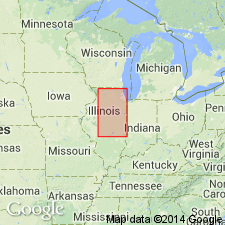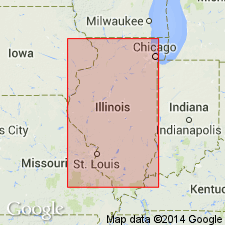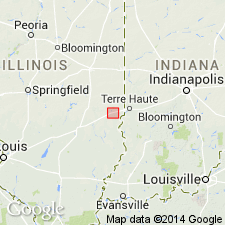
- Usage in publication:
-
- Berry Clay Member
- Modifications:
-
- Named
- Dominant lithology:
-
- Clay
- Silt
- AAPG geologic province:
-
- Illinois basin
Summary:
Named Berry Clay Member of the Glasford Formation for town of Berry, Sangamon Co., IL. Consists of 0.6 to 1.6 m of gray, accretion-gley of clay, silt, and pebbles. Unit overlies various members of the Glasford Formation and underlies the Roxana Silt, Robein Silt, Peoria Loess, or Wedron Formation. The Berry is of Pleistocene (Illinoian) age.
Source: GNU records (USGS DDS-6; Reston GNULEX).

- Usage in publication:
-
- Berry Clay Member
- Modifications:
-
- Overview
- AAPG geologic province:
-
- Illinois basin
Summary:
Berry Clay Member of the Glasford Formation was deposited and pedogenically modified during the Sangamonian Age and Altonian Subage (approximately 130 ka to 40 ka according to fig. 2). Unit has two facies: a soft, leached and gleyed, upward-fining loam to clay diamicton (accretion gley), and a less-common, more-oxidized facies composed of loam diamicton. Both facies are colluvial. Base of the Berry Clay is marked locally by a stone line or sandy, gravelly zone.
Source: GNU records (USGS DDS-6; Reston GNULEX).

- Usage in publication:
-
- Berry Clay Member
- Modifications:
-
- Revised
- AAPG geologic province:
-
- Illinois basin
Summary:
Beneath the upland surfaces in the study area, the Berry Clay Member of the Glasford Formation forms a continuous layer over the Vandalia Till Member and under the sandy silt facies of the Roxana Silt. In this report, the Berry Clay Member is included in the upper Pearl Formation to emphasize the continuity of this mantle Unit is composed of leached and pedogenically modified loam to clay loam diamicton. Average thickness of the Berry is 5 ft; maximum thickness is 13 ft. B horizon of the Sangamon Soil commonly occurs in the Berry. Where the Pearl sand is absent, the contact between the Berry and the Vandalia generally is abrupt. Contact with the Roxana is gradational. Age is Pleistocene (Sangamonian).
Source: GNU records (USGS DDS-6; Reston GNULEX).
For more information, please contact Nancy Stamm, Geologic Names Committee Secretary.
Asterisk (*) indicates published by U.S. Geological Survey authors.
"No current usage" (†) implies that a name has been abandoned or has fallen into disuse. Former usage and, if known, replacement name given in parentheses ( ).
Slash (/) indicates name conflicts with nomenclatural guidelines (CSN, 1933; ACSN, 1961, 1970; NACSN, 1983, 2005, 2021). May be explained within brackets ([ ]).

